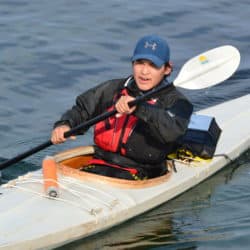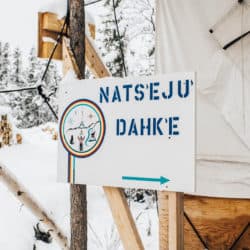For the North and by the North. Six little words that mean so much.
Since 2012, when the Arctic Inspiration Prize (AIP) was established, these six words have been its guiding principle. Says Kristina Kane, chief of the Ta’an Kwach’an Council in Whitehorse, the prize is about “honouring champions who use their creativity, innovation, and commitment to the North to make a difference in our communities. Together we build a strong North, for the North and by the North.”
The AIP, dubbed the “Nobel of the North” by former national selection committee member Peter Mansbridge, recognizes extraordinary contributions in the gathering of Arctic knowledge and its real-world implementation to create innovative, community-driven projects in the areas of education, housing, health, performing arts, traditional knowledge, language, and science.
In the nine years since it was launched, the AIP has enabled 35 prizewinners, called laureates, to bring their ideas to life for the benefit of the Canadian Arctic, home to more than 150,000 people, the majority of whom are Indigenous.
One aspect of the AIP makes it stand out from other funding organizations: the money is used entirely at the discretion of the project teams, with no restrictions or limitations. “The Arctic Inspiration Prize isn’t about telling Northerners what to do. This prize is about supporting Northerners who already have solutions,” says Chief Kluane Adamek, Yukon Regional Chief of the Assembly of First Nations.
The prizes, in three categories, are significant: typically, one exceptional team wins $1 million, and a number of prizes of up to $500,000 and $100,000 (for youth laureates) are awarded, for a total of $3 million each year.
The AIP’s flexible philanthropy model allows laureates to leverage their prize money to secure additional funding – often thanks to the acknowledgement, visibility, and prestige associated with the AIP – and develop and implement projects that are responsive to the needs of their communities. This approach also allows project teams to easily adapt to external factors, such as the COVID-19 pandemic. Laureates from 2019 were not required to submit paperwork to redirect funds to be spent in the following year when their projects were stalled; instead, they were able to focus their efforts on dealing with the impacts of the pandemic.
Funding northern innovation
Through the AIP’s seed-funding, laureates have the opportunity to learn from the work of other communities across the North while pursuing their own projects. The funding also makes it possible to expand projects to other communities.
“Most other funding applications have very strict criteria. In comparison, the AIP is focused on ideas that can help the community. It is a resource that can help you realize your dream of making your community better, by bringing your ideas to life,” says Glen Brocklebank, a 2017 laureate. “It provides the opportunity to make the North stronger and better. You are only limited by how you limit yourself.”
Northern ownership, leadership, and inspiration
In 2015, the Arctic Inspiration Prize Charitable Trust was settled to establish northern ownership of the prize, and the motto was expanded: by the North and for the North, with the unconditional support of the south. With an endowment of approximately $50 million, the trustees work to ensure the prize’s sustainability so that many more teams can see their solutions put into action.
The AIP’s Indigenous-led selection process, consisting of three regional selection committees (from Yukon, the Northwest Territories, and Inuit Nunangat) that make recommendations to the national selection committee, ensures the winning projects are the most relevant for the communities they intend to serve. Local volunteers – the people who know, understand, and live in the recipient communities – decide what’s most important. “They can understand what you are trying to do and appreciate the challenges you are trying to overcome,” says Trevor Bell, a 2016 laureate with the SmartICE project.
Capacity-building for the future
Past laureates speak with pride and humility, their focus squarely on the people in their communities and their contribution to making those communities stronger for future generations. “It is about building confidence and capacity and sustainable lifestyles,” says Verna Pope, 2018 laureate for the Traditional Techniques Tweaked to Galvanize Indigenous Northern Artisans.
Laureates stress the importance of empowering the next generation to harness traditional knowledge to solve modern-day challenges for a stronger tomorrow. “Our sculpture represents our resilience, our time, our future,” says Kaitak Allukpik, 2018 laureate for the From Scrap to Art project.
Over the following months, The Philanthropist will feature a number of these laureates and their innovative solutions to addressing community challenges across the Arctic.
These award-winning projects include developing an Indigenous-owned and -operated artist co-op in the Northwest Territories; revitalizing the traditional art of making qajaqs (the Inuktitut spelling of “kayak”) by connecting young people with local knowledge keepers and Elders in Nunavut; and finding culturally appropriate supports for families dealing with psychosocial problems related to post-traumatic stress, depression, addiction, and incarceration in Nunavik. Each project exemplifies Northerners’ ingenuity, creativity, and resilience.
An excellent example of that ingenuity is the Nunatsiavut-based SmartICE (short for “Sea-Ice Monitoring and Real-Time Information for Coastal Environments”) project. Historically, sea-ice travel expanded opportunities for hunting and for gathering firewood and provided access to neighbouring communities over the winter months. Climate change has introduced new concerns, however. The later onset of winter, shorter periods of deep freeze, more rain, and changeable snow and wind all make sea ice less predictable. Established as a social enterprise, SmartICE was awarded $400,000 in 2016 to develop a near-real-time monitoring and reporting system for sea ice. SmartICE’s multidisciplinary partnership – which includes community, academic, government, and industry members – integrates traditional Inuit knowledge to inform decisions about coastal sea-ice travel and shipping. This partnership led to the development and adaptation of technology for testing ice temperature and thickness. The 2020 ice season saw Inuit from 17 communities, from Nunatsiavut to Inuvialuit, trained to operate the equipment and technology, with seven other communities in the planning stages.
A project in Pond Inlet, Nunavut, was developed to address a community’s desire for a culturally relevant early-childhood-education program. In 2018, the Pirurvik: A Place to Grow project was awarded $1 million to develop an innovative and comprehensive program rooted in the Inuit Qaujimajatuqangit (traditional knowledge) principle of pilimmaksarniq: the practice of allowing children to learn at their own pace by following their natural curiosity and choosing topics that interest them. What started as a grassroots effort by two mothers quickly grew into seven community-specific programs throughout Nunavut. There is now a long waiting list of communities that would like to have similar programs developed.
2020 awards ceremony
Last November, members of the three regional selection committees selected 10 nominees as finalists for the 2020 AIP. Ranging in scope and focus, each project demonstrates the potential to generate lasting impact across the North. Laureates in all three prize categories have been chosen by the national selection committee and will be announced at the ninth annual awards ceremony on February 19.
As with many other events over the past year, the COVID-19 pandemic has forced organizers to adjust their plans, but it won’t stop the celebration. The AIP had planned to host the awards ceremony in Whitehorse in partnership with the Yukon First Nation Chamber of Commerce, the Arctic Indigenous Investment Conference (AIIC), and the Yukon Arts Centre; instead, for the first time ever, this year’s virtual ceremony will be broadcast on television and the web across the country, thanks to a partnership with APTN. With Dene singer/songwriter Leela Gilday once again taking the lead as artistic director, it promises to be an ambitious, pan-Arctic celebration that will bring this year’s laureate success stories to living rooms from north to south and east to west.
The finalists in the $1-million prize category are:
- Ilagiitigut anngiangijaqatigiinnirq ilurqusivuttigut, a project that addresses substance abuse by focusing on intergenerational trauma, the reclamation of Inuit identity and culture, and connection to the land;
- Imaa, Like This: Children and Youth Expressing Themselves Through Music, a program that aims to create culturally relevant music-education resources for children and increase access to music education across Nunavut; and
- Northern Centre for Justice, Dignity and Leadership, a program that would strengthen services and supports for those harmed by violence in the Yukon, particularly Indigenous women and girls, and deliver an Indigenous-led education program for service providers that offers a new understanding of violence.
In addition to supporting northern innovation, the AIP also supports performers and artists by showcasing northern talent as part of the annual awards ceremony. Each year, laureates receive original works by artists from Yukon, the Northwest Territories, the Inuvialuit Settlement Region, Nunavut, and Nunavik. In 2019, laureates received artwork provided with the support of Fire and Ice Studio and arts and culture partners Avataq Cultural Institute and the Yukon First Nations Culture and Tourism Association. This year’s performers include Juno Award–winner Leela Gilday, Yukon’s Dakhká Khwáan Dancers, NWT fiddling sensation Wesley Hardisty; Nunavut’s Silla and Rise, and Nunatsiavut’s Pan Lab Alumni Choir.
***
“I’m so happy this evening that so many of the prizes are going to nurture that spark in people,” said Aluki Kotierk, president of Nunavut Tunngavik Incorporated, at the 2019 awards ceremony. “We all need to play that role – whether we are from organizations, whether we do it individually, whether we do it as family – we need to create the spaces and environment so we can all become who we were meant to be. Confidently. Unapologetically. So that we can contribute positively to our communities, to our families, to our territories.”


